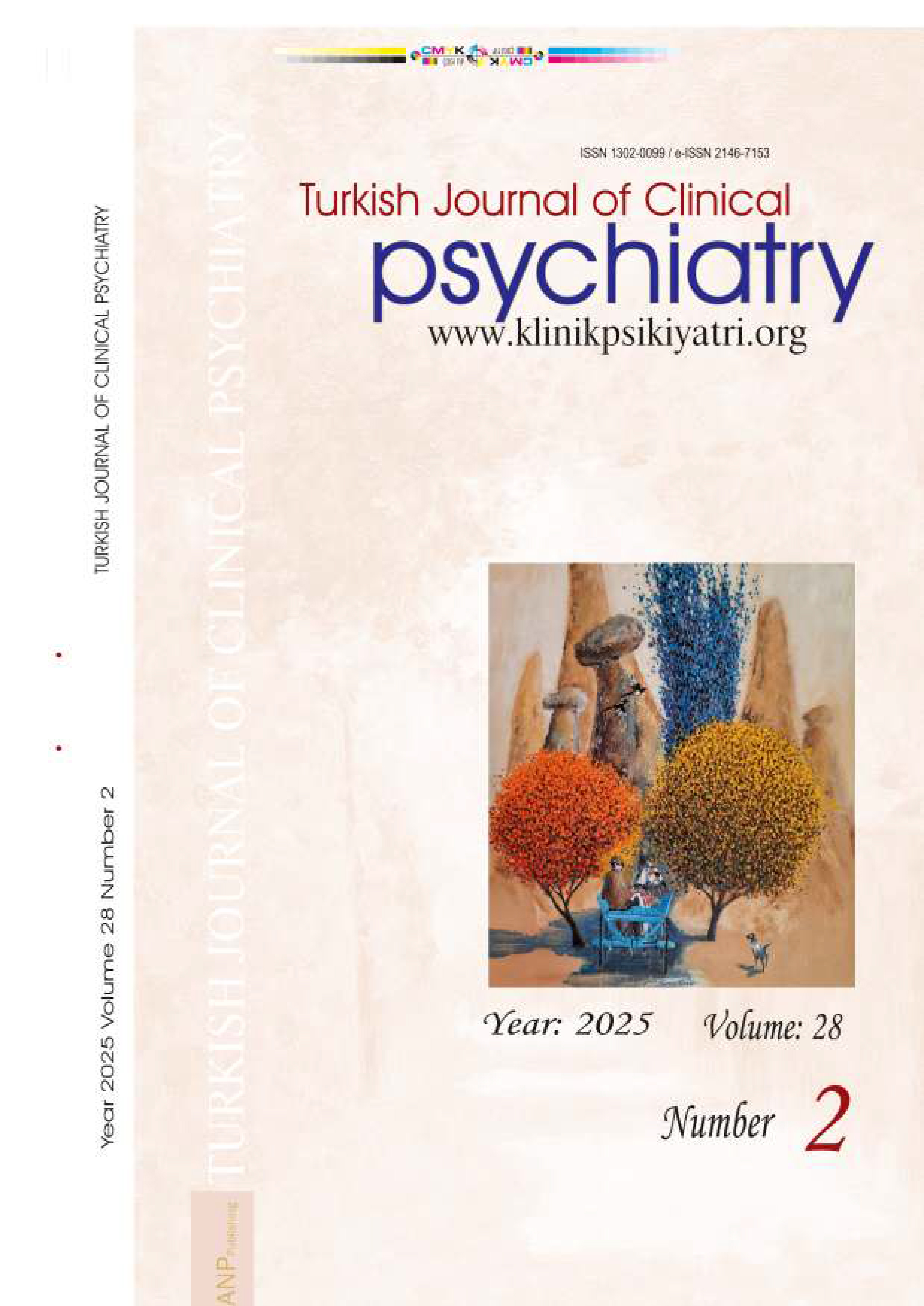





Volume: 22 Issue: 1 - 2019
| EDITORIAL | |
| 1. | Ethics and boundaries in mental health Mehmet Yumru doi: 10.5505/kpd.2019.75537 Pages 5 - 6 Abstract | |
| RESEARCH ARTICLE | |
| 2. | The relationships among impulsivity, anxiety sensitivity characteristics, and severity of social anxiety disorder (eng) Safiye Bahar Ölmez, Ahmet Ataoğlu doi: 10.5505/kpd.2018.47560 Pages 7 - 15 INTRODUCTION: The purpose of this study is to examine the characteristics of impulsivity and anxiety sensitivity in patients with Social Anxiety Disorder (SAD) and to investigate relationships between these characteristics and the severity of SAD. METHODS: The sample consisted of outpatients (n=51) who had been diagnosed with only SAD based on the American Psychiatric Association’s Diagnostic and Statistical Manual of Mental Disorder, in addition to healthy individuals (n=51) serving as the control group. Data collection tools were the socio-demographic form, the Barratt Impulsivity Scale (BIS-11), the Anxiety Sensitivity Index (ASI-3), and Liebowitz Social Anxiety Scale (LSAS). RESULTS: The mean total score of the BIS-11 in the SAD group was found to be significantly higher than the mean total BIS-11 score in the control group (p <0.001). Compared to the mean total ASI-3 score, the SAD group’s mean score was significantly higher than the control groups mean scores (p <0.001). The analysis of variance revealed that the cognitive and social dimensions and total ASI-3 scores were positively correlated with total LSAS scores (r=0.434, r=0.427, and r=0.351, respectively). Additionally, there was a negative correlation between the attention impulsivity subscore and the LSAS avoidance subscore (r=-0.353). DISCUSSION AND CONCLUSION: Patients with SAD have more impulsivity and anxiety sensitivity characteristics than healthy individuals. Moreover, anxiety sensitivity and attention impulsivity characteristics of patients with SAD are associated with symptom severity. |
| 3. | Investigation of the effect between care burden and quality of life in caregivers of schizophrenia patients (tur) Hakan Karaağaç, Esra Çalık Var doi: 10.5505/kpd.2018.60783 Pages 16 - 26 INTRODUCTION: This study was conducted to investigate the effect between care burden and quality of life of caregivers of schizophrenia patients treated at Kayseri Education and Research Hospital Community Mental Health Center and Psychiatry Clinic. METHODS: In the selection of samples, purposive sampling method was used and 146 persons were included in the study. In the collection of data; Sociodemographic Information Form, Zarit Care Burden Scale and WHOQOL-BREF-TR were used. The obtained data were tested in SPSS 23 program by number, percentage, frequency, t test, ANOVA, Pearson correlation analysis and multiple regression analysis. RESULTS: Caregivers; mean age was 45, the patients were given care a mean of 8.5 years and 54.8% were women. The quality of life physical health subscale; burden of care total score, deterioration in social relations and economic burden were negatively affected. It was determined that the total score of spiritual tension, economic burden and burden of care total score negatively affected the psychological sub-dimension of quality of life. It was concluded that the social relations sub-dimension of quality of life negatively affected the sub-dimensions of care burden, mental stress and deterioration in social relations. The quality of life environmental subscale are affected only economic burden. DISCUSSION AND CONCLUSION: Mental health diseases affect the lives of not only the patients but also the patients' relatives, and caregivers may need support in this process. Consideration of the caregivers of schizophrenic patients as well as their caregivers, when existing programs are being assessed, may support schizophrenia patients within the family system and promote holistic approach to the disease. |
| 4. | Analysis of psychological factors and sexual life in postmenopausal women: A cross-sectional study (eng) Seren Akman, Mehmet Çakıcı, Buse Keskindağ, Meryem Karaaziz doi: 10.5505/kpd.2018.58070 Pages 27 - 35 INTRODUCTION: The aim of this study was to analyze the psychological and sexual experiences of postmenopausal women. METHODS: This cross-sectional study included 100 females (50 postmenopausal and 50 non-menopausal women). The symptoms of menopause were assessed by the Menopausal Symptoms Scale (MRS), psychological symptoms were assessed by the Symptoms Check List (SCL-R 90), and sexual functions were evaluated by the Arizona Sexual Experience Scale (ASEX) and the Golombok Rust Inventory of Sexual Satisfaction (GRISS). RESULTS: The findings indicated that mean scores of all subscales of the SCL-R 90 were significantly higher among postmenopausal women in comparison with non-menopausal women. No significant differences were found between postmenopausal and non-menopausal women in terms of sexual satisfaction. However, mean scores of vaginusmus and anorgasmia subscales of the GRISS were significantly higher in postmenopausal women than non-menopausal women. DISCUSSION AND CONCLUSION: This study showed that menopause may affect women’s mental health because of its psychological consequences. Although menopause can influence sexuality because of physical consequences, findings indicated that menopausal women tend to report they still have sexual satisfaction. Multidimensional health care including psychological support could be efficient for menopausal women. |
| 5. | Evaluation of post-traumatic stress disorder, burnout and coping styles in emergency and intensive care unit employees (tur) Erkan Baysak, Meliha Zengin Eroğlu, Çisem Utku, Burhanettin Kaya doi: 10.5505/kpd.2018.55707 Pages 36 - 47 INTRODUCTION: Although it’s well known that Post-Traumatic Stress Disorder (PTSD) is frequent in intensive care and emergency departments employees, this subject has been studied very rare. PTSD frequency, burnout and the methods of coping with PTSD were investigated in our study in employees working at this area from various hospitals from our country. METHODS: Data of 123 emergency department, 139 intensive care unit employees and 133 control included from different centers to the study were evaluated. The Posttraumatic Diagnostic Scale, Maslach Burnout Inventory, Hospital Anxiety and Depression Scale, Coping Style Scale and sociodemographic data form developed for the study were applied to all participants. RESULTS: The rates of PTSD in emergency employees, in intensive care unit employees and in controls were 23.6%, 15.8% and 6% respectively.The HAD scores of both the emergency and intensive care groups were higher than the control group. DISCUSSION AND CONCLUSION: Emergency and intensive care unit employees are risky people for especially PTSD and psychiatric disorders such as anxiety and depression. Various precautions must be taken at this kind of workplaces in terms of preventive mental health. |
| 6. | Sexual functions and prolactin levels in patients with bipolar disorder (tur) Rabia Nazik Yüksel, Elif Tatlıdil Yaylacı, Hasan Kaya, Gamze Erzin, Emine Merve Akdağ, Adem Demirci, Çiğdem Aydemir, Erol Göka doi: 10.5505/kpd.2019.03521 Pages 48 - 56 INTRODUCTION: Mood stabilizers and antipsychotic drugs are known to have adverse effects on sexual function. However, patients often refrain from speaking about sexual complaints that may cause dose reduction and discontinuation of the drug without medical supervision. In this study we aimed to evaluate sexual functions of patients with bipolar disorder in remission period, considering prolactin levels and medications. METHODS: We recruited 52 patients with bipolar disorder in remission according to DSM-IV diagnostic criteria. Prolactin levels were measured in all patients. The Golombok Rust Inventory of Sexual Satisfaction (GRISS) was used to assess sexual dysfunction. RESULTS: Mean prolactin levels were 24.71 ± 4.25 and 19.96 ± 5.52 ng/ml respectively for females and males. Patients taking mood stabilizer (MS) and mood stabilizer plus antipsychotic (AP) treatment had different prolactin levels (p<0.001). Total GRISS scores were not different for MS and MS+AP treatment groups. We didn’t find a correlation between Total GRISS scores and prolactin levels. There was a significant deterioration in female non-sensuality, female dissatisfaction and anorgasmia subscales of female patients and significant deterioration in premature ejaculation, impotence and male dissatisfaction subscales of male patients. DISCUSSION AND CONCLUSION: In our sample, both men and women patients with bipolar disorder in remission have sexual dysfunctions. Our results suggest that prolactin levels are not sufficient to demonstrate the sexual dysfunction. To enhance patient compliance it is necessary to focus more on sexual symptoms of patients receiving MS and AP treatment. |
| 7. | A medical school students' mental disorders attitudes (tur) Ferdi Köşger, Ali Ercan Altınöz PMCID: PMC22 doi: 10.5505/kpd.2018.78941 Pages 57 - 62 INTRODUCTION: Stigmatization for mental illness is a phenomenon that is seen all over the world and its negative effect on individuals with mental disorders has been shown strongly with studies done up to day. It is known that the stigmatizing attitude towards mental illness is also seen among the medical faculty students as well. In this study, it was aimed to investigate the attitudes of students of Eskişehir Osmangazi University (ESOGÜ) Faculty of Medicine to mental disorders regarding to sociodemographic variables. METHODS: The study is conducted between December 2017 and April 2018; the sample was consisting of the volunteer students of Eskişehir Osmangazi University School of Medicine. In our study, sociodemographic information form and Beliefs Towards Mental Illness Scale (BTMIS) were used as data collection tool. RESULTS: 314 students who agreed to participate in the study were assessed. Twenty-four of the participants (7.6%) reported a psychiatric diagnosis, and 63 (20.1%) had a psychiatric diagnosis. When comparing the scores of BTMIS scores by sex, the mean scores of male students were significantly higher than female students (z = 2.65, p <0,01). DISCUSSION AND CONCLUSION: It is consistent with the literature that women, the students with high education, the students with psychiatric disorders, and the student who had a relative with psychiatric disorder had more positive attitudes. It is important to improve the stigmatization awareness toward the medical students. |
| 8. | Turkish adaptation of emotion regulation skills questionnaire-emotion specific: The study of reliability and validity (tur) Sevginar Vatan doi: 10.5505/kpd.2018.52824 Pages 63 - 70 INTRODUCTION: The aim of this study was to bring one of the emotional regulation measurements to Turkish Language. For this, we evaluated validity and reliability of the Emotion Regulation Skills Questionnaire-Emotion Specific in a Turkish sample. METHODS: In total 514 university students (295 female and 219 male) participated and completed Emotion Regulation Skills Questionnaire-Emotion Specific, Emotion Regulation Skills Questionnaire, and SCL-90 RESULTS: In the reliability study, the Cronbach alphas for different emotions subscales were between.86 and.92. Most of the item total correlations were higher than.30. Additionally, in the validity study the whole scale and subscales were revealed high correlations with each other and variables used for criterion validity. DISCUSSION AND CONCLUSION: To sum up, the results suggest that the validity and reliability of the Turkish form of Emotion Regulation Skills Questionnaire –Emotion Specific was at a satisfactory level. |
| 9. | The attitudes of high school adolescent toward crime and risk factors (tur) Ezgi Sarı, Hülya Arslantaş doi: 10.5505/kpd.2018.81894 Pages 71 - 82 INTRODUCTION: In adolescence, where development and change are experienced intensively, there is a greater risk of criminal behavior. So this study was planned to determine the suicidal attitudes and the risk factors for suicidal attitudes of healthy adolescents between 14-18 years of age. METHODS: The research was conducted with the participation of adolescents between the ages of 14 and 18 who were studying at 9 schools selected as representative schools. The Personal Information Form and Attitudes Against Crime were used as data collection tools. In the analysis of the data, descriptive statistics were obtained from the non-parametric tests Kruskal Wallis Test and to determine the difference between groups Mann-Whitney U. RESULTS: Adolescents participating in the survey were identified 58,5% (n=857) were male, 29.7% (n=435) 17 age, %35,7% (n=523) industrial had their education in vocational schools. Against crime attitudes with gender(z=-4,958 p=0,000), age(KW=14,354 p=0,006), the common type of school education(KW=81,615 p=0,000), parents' educational status(KW=41,675 p=0,000;KW=32,730 p=0,000), family income level(KW=15,193 p=0.001), attitude towards parents and adolescents(KW=41,640 p=0,000), the presence of the convicted individual in the family(KW=11,837 p=0,008), wrong behaviour of the family as a result of the penalty to adolescents(z=-3,745 p=0,000), the level of academic achievement of adolescents(KW=18,426 p=0,000), disciplinary investigations at school passed(z=-6,103 p=0,000) with friends and their incidence in incorrect behavior(KW=83,033 p=0,000) between the statistically significant relationship has been identified. DISCUSSION AND CONCLUSION: The adolescents who is male, were oppressed and indifferent to family attitudes towards them, whose family debates were frequent and who were subjected to punishment with violent content and who were convicted of fathers in the family, low parental education levels and wrong behavior with their friends were more likely to approve of criminal behavior. It is necessary to raise awareness and protect the family, school and peer characteristics that cause inappropriate attitudes towards crime behavior and create risk. |
| 10. | Examination computer gaming addiction, alexithymia, social anxiety, age and gender among children aged 8-12 (tur) İbrahim Taş, Zehra Güneş doi: 10.5505/kpd.2018.17894 Pages 83 - 92 INTRODUCTION: Computer gaming addiction is also a type of behavioral addiction dealing with in the context of technological dependencies. It is seen that this addictive type has the most negative effects on children. The aim of this study is to examine age, gender, alexithymia and social anxiety as predictors of computer gaming addiction among children. METHODS: The research was carried out on a total of 321 persons, 148 of whom were girls and 173 were boys. The ages of the participants were between 8 and 12 and their average age was 10.48. Research data were collected via Computer Gaming Addiction Scale for Children, Alexithymia Scale for Children, Social Anxiety Scale for Children and Personal Information Form. Parametric tests were used because it was found that the data of research were normally distributed and met the necessary assumptions for multiple regression. The data obtained from the research were analyzed by Pearson Correlation Analysis and Hierarchical Regression Analysis method. RESULTS: In the study, a positive correlation has been found between computer gaming addiction and alexithymia and social anxiety. In addition, age, gender, alexithymia and social anxiety significantly predicted computer gaming addiction at 24.1%. In the research, it was identified that the most effect in explaining computer gaming addiction was alexithymia, followed by gender and social anxiety. DISCUSSION AND CONCLUSION: As a result, it is found out that gender, alexithymia and social anxiety affect computer gaming addiction in children significantly. The results of research were discussed in the light of the literature and suggestions were made to the researchers and experts studying in the field. |
| 11. | Relationship between childhood abuse experiences, cognitive distortions and loneliness levels of high school students (tur) Tuğba Türkkan, Hatice Odacı doi: 10.5505/kpd.2018.40427 Pages 93 - 103 INTRODUCTION: Childhood abuse experiences and their traumatic consequences have the characteristics that greatly affect the individual's future life. For this reason, it is thought that determining the variables related to neglect and abuse will be a guide for awareness-raising and prevention efforts to be made. In this study, the relationship between childhood abuse experiences, cognitive distortions and loneliness levels of high school students was investigated. METHODS: Study group consisted of 703 high school students. The participants were asked to complete Demographic Information Form, Childhood Trauma Questionnaire, The Interpersonal Distortions Scale and UCLA Loneliness Scale. The data were analysed using Spearman’s Brown Rank Test and multiple regression. RESULTS: The results of the data analysis indicated that a statistically significant relationship was found between physical abuse sub-dimension of childhood abuse experiences and avoidance from proximity sub-dimension of interpersonal distortions in positive way; mind reading sub-dimension of interpersonal distortions in negativeway. Also, therewas a significant positive correlation between sexual abuse sub-dimension of childhood traumatic experiences and avoidance from proximity sub-dimension of interpersonal distortions. It was found out that emotional abuse sub-dimension of childhood abuse experiences displayed a significant relationship with avoidance of proximitysub-dimension of interpersonal distortions in positive way; whereas with unrealistic expectations of relationships and mind reading sub-dimensions of interpersonal distortionsin negative way. Also it was found that childhood abuse experiences explained the 5% of the avoid proximity sub-dimension of cognitive distortions and 17% of the loneliness level. DISCUSSION AND CONCLUSION: Results of the study indicated that all sub-dimensions of childhood abuse experiences were related to sub-dimensions of cognitive distortions and loneliness levels. |
| REVIEW | |
| 12. | Neural correlates of self: Models of Northoff and Damasio (tur) Zahide Tepeli Temiz, Lütfü Hanoğlu doi: 10.5505/kpd.2018.41275 Pages 104 - 115 Self has been one of the most controversial phenomenon in philosophy and psychology for a long time. More recently, self has been transferred in the field of neuroscience since 30 years and its neural correlates remain under the intense investigations. Proposals for theoretical conception of self have not yet achieved complete clarity. Efforts for linking the self with brain structures have been going on for many years. Naturally, these two states (theorization and experiments) process side by side. Therefore, neuroscientific studies diversify with regard to conceptual theorization of self. Many studies have shown that cortical midline structures (CMS) are important in self processing. In addition, it is commonly accepted the involvement of resting state activity during the self-related mental states. In this context, processing of self related stimulus in the cortical midline structures is associated with regions of default mode network (DMN). This review aims to investigate the self-related studies under the light of current neuroscientific data, the neuroscience model of Northoff proposed for the self, and to examine the self in the Damasio’s framework in the context of consciousness. |
| LETTER TO EDITOR | |
| 13. | Duodenal perforation in a patientwith heroin use (eng) Ümit Haluk Yeşilkaya, Yasin Hasan Balcıoğlu, Mehmet Cem İlnem doi: 10.5505/kpd.2018.29484 Pages 116 - 118 A number of vascular pathologies are attributed to the opiate exposure such as myocardial infarction, ischaemic stroke, and hypoperfusion of the gastrointestinal tract. Here we presented a 30-year-old male patient with no history of any ischemic or gastrointestinal disease known to have 10-year opioid use and had suffered a duodenal perforation. Prolonged exposure of opioids may lead to hypersensitivity reactions, ischemia and hypoperfusion and combination of these entities with opioid-related gastrointestinal motility deficits could contribute to the epithelial damage and perforation as a consequence. The presence of ischemic events should be kept in mind in the presence of gastrointestinal symptoms in people using intensive heroin. |










